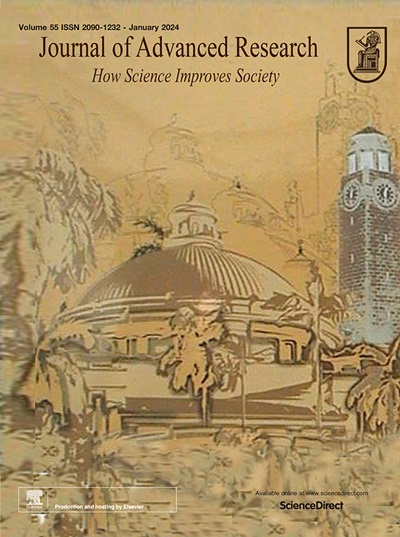Reveal the mechanism of hepatic oxidative stress in mice induced by photo-oxidation milk using multi-omics analysis techniques
IF 11.4
1区 综合性期刊
Q1 MULTIDISCIPLINARY SCIENCES
引用次数: 0
Abstract
Introduction
Photo-oxidation is recognized as a contributor to the deterioration of milk quality, posing potential safety hazards to human health. However, there has been limited investigation into the impact of consuming photo-oxidized milk on health.
Objectives
This study employs multi-omics analysis techniques to elucidate the mechanisms by which photo-oxidized milk induces oxidative stress in the liver.
Methods
Mouse model was used to determine the effect of the gavage administration of milk with varying degrees of photo-oxidation on the mouse liver. The damage degree was established by measuring serum markers indicative of oxidative stress, and with a subsequent histopathological examination of liver tissues. In addition, comprehensive metabolome, lipidome, and transcriptome analyses were conducted to elucidate the underlying molecular mechanisms of hepatic damage caused by photo-oxidized milk.
Results
A significant elevation in the oxidative stress levels and the presence of hepatocellular swelling and inflammation subsequent to the gavage administration of photo-oxidized milk to mice. Significant alterations in the levels of metabolites such as lumichrome, all-trans-retinal, L-valine, phosphatidylglycerol, and phosphatidylcholine within the hepatic tissue of mice. Moreover, photo-oxidized milk exerted a pronounced detrimental impact on the glycerophospholipid metabolism of mice liver. The peroxisome proliferator-activated receptors (PPAR) signaling pathway enrichment appreciated in the animals that consumed photo-oxidized milk further supports the substantial negative influence of photo-oxidized milk on hepatic lipid metabolism. Gene set enrichment and interaction analyses revealed that photo-oxidized milk inhibited the cytochrome P450 pathway in mice, while also affecting other pathways associated with cellular stress response and lipid biosynthesis.
Conclusion
This comprehensive study provides significant evidence regarding the potential health risks associated with photo-oxidized milk, particularly in terms of hepatic oxidative damage. It establishes a scientific foundation for assessing the safety of such milk and ensuring the quality of dairy products.
利用多组学分析技术揭示光氧化牛奶诱导小鼠肝脏氧化应激的机制
导言:光氧化被认为是导致牛奶质量下降的一个因素,对人类健康构成潜在的安全隐患。然而,关于食用光氧化牛奶对健康的影响的调查却很有限:本研究采用多组学分析技术来阐明光氧化牛奶诱导肝脏氧化应激的机制:方法:采用小鼠模型确定灌胃不同光氧化程度的牛奶对小鼠肝脏的影响。损伤程度是通过测量血清中指示氧化应激的标志物以及随后对肝组织进行组织病理学检查来确定的。此外,还进行了全面的代谢组、脂质组和转录组分析,以阐明光氧化牛奶造成肝损伤的潜在分子机制:结果:小鼠灌胃光氧化牛奶后,氧化应激水平明显升高,出现肝细胞肿胀和炎症。小鼠肝脏组织中的代谢物,如发光色素、全反式视网膜色素、L-缬氨酸、磷脂酰甘油和磷脂酰胆碱的水平发生了显著变化。此外,光氧化牛奶对小鼠肝脏的甘油磷脂代谢产生了明显的不利影响。在饮用光氧化牛奶的动物体内发现的过氧化物酶体增殖激活受体(PPAR)信号通路富集进一步证实了光氧化牛奶对肝脏脂质代谢的实质性负面影响。基因组富集和相互作用分析表明,光氧化牛奶抑制了小鼠的细胞色素 P450 通路,同时也影响了与细胞应激反应和脂质生物合成相关的其他通路:这项综合研究提供了与光氧化牛奶相关的潜在健康风险的重要证据,特别是在肝脏氧化损伤方面。它为评估此类牛奶的安全性和确保乳制品的质量奠定了科学基础。
本文章由计算机程序翻译,如有差异,请以英文原文为准。
求助全文
约1分钟内获得全文
求助全文
来源期刊

Journal of Advanced Research
Multidisciplinary-Multidisciplinary
CiteScore
21.60
自引率
0.90%
发文量
280
审稿时长
12 weeks
期刊介绍:
Journal of Advanced Research (J. Adv. Res.) is an applied/natural sciences, peer-reviewed journal that focuses on interdisciplinary research. The journal aims to contribute to applied research and knowledge worldwide through the publication of original and high-quality research articles in the fields of Medicine, Pharmaceutical Sciences, Dentistry, Physical Therapy, Veterinary Medicine, and Basic and Biological Sciences.
The following abstracting and indexing services cover the Journal of Advanced Research: PubMed/Medline, Essential Science Indicators, Web of Science, Scopus, PubMed Central, PubMed, Science Citation Index Expanded, Directory of Open Access Journals (DOAJ), and INSPEC.
 求助内容:
求助内容: 应助结果提醒方式:
应助结果提醒方式:


